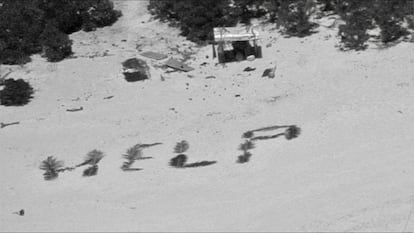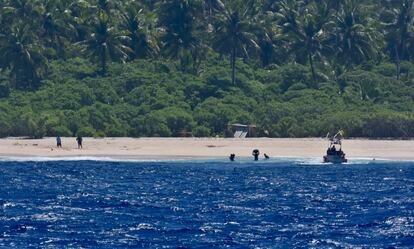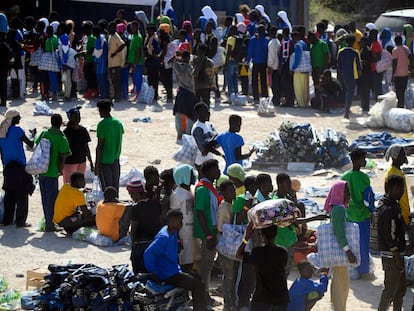Three sailors rescued in the Pacific after calling for help with palm leaves
The stranded mariners wrote ‘HELP’ on the sand in Pikelot, in Micronesia, and the message was seen by the U.S. Coast Guard operating in the area


Four letters written with palm leaves on the sand were crucial to the rescue of three sailors who were shipwrecked on a small, uninhabited atoll in the Pacific. “HELP” was the message that the rescue teams flying over the area read from the plane. After being stranded for over a week, all three are safe, according to the United States Coast Guard.
The three mariners, all men in their 40s, embarked on their voyage from Polowat Atoll in Micronesia on Easter Sunday in a small 20-foot open skiff equipped with an outboard motor and experience in navigating these waters, the Coast Guard release said.
On April 6, a Coast Guard unit in Guam received a distress call from a relative of the three mariners reporting her three uncles had not returned from Pikelot Atoll, approximately 100 nautical miles northwest of Polowat Atoll.
Watchstanders of this unit, the Joint Rescue Sub-Center (JRSC), immediately began coordinating a search and rescue operation. There were initial difficulties in mobilizing air assets due to lack of availability, operational commitments and weather conditions. Ultimately, the efforts led to the mobilization of a U.S. Navy P-8 crew from Kadena Air Force Base in Japan and the diversion of the Coast Guard Cutter Oliver Henry. The initial search area spanned over 78,000 square nautical miles.

The breakthrough came when the U.S. Navy’s P-8 Poseidon aircraft identified the three sailors on April 7 at Pikelot Atoll, confirming their presence and status. “In a remarkable testament to their will to be found, the mariners spelled out ‘HELP’ on the beach using palm leaves, a crucial factor in their discovery. This act of ingenuity was pivotal in guiding rescue efforts directly to their location,” said Lt. Chelsea Garcia, the search and rescue mission coordinator on the day they were located.
The aircraft crew successfully deployed survival packages to sustain the mariners until further assistance could arrive. USCGC Oliver Henry was rerouted to Pikelot Atoll to conduct the rescue operation. The crew of the coast guard vessel met the sailors on the atoll on the morning of April 9, rescued the men and returned them to Polowat Atoll along with their skiff, which had sustained damage making its outboard engine non-functional.
This is the second rescue mission to take place in similar circumstances in a few years in Pikelot. In August 2020, an SOS message written on the sand of that same Pacific atoll was key in the rescue of three sailors who had been shipwrecked on the journey between Pulawat and Pulap atolls. They spent three nights and two days outdoors, but the pattern in the sand was enough for the Coast Guard to locate them and rescue them safe and sound.
In April 2016, three men were rescued from the small, uninhabited island of Fanadik, also in Micronesia, after their boat sank almost four kilometers from the coast. These castaways wrote a gigantic “HELP” with palm leaves and were rescued by the United States Navy three days later.
In August of that same year, a couple was rescued from the desert island of East Fayu, also in Micronesia, after a U.S. Navy aircraft that flew over the atoll read the SOS signal they had written in the sand.
With a primary presence in Guam and Saipan and over 300 members across Guam and the Commonwealth of the Northern Mariana Islands, the U.S. Coast Guard Forces Micronesia/Sector Guam team focuses on maritime safety, security, and stewardship in Oceania. They have search and rescue responsibility for maritime events over more than 1.9 million square miles, including the Federated States of Micronesia.
Sign up for our weekly newsletter to get more English-language news coverage from EL PAÍS USA Edition
Tu suscripción se está usando en otro dispositivo
¿Quieres añadir otro usuario a tu suscripción?
Si continúas leyendo en este dispositivo, no se podrá leer en el otro.
FlechaTu suscripción se está usando en otro dispositivo y solo puedes acceder a EL PAÍS desde un dispositivo a la vez.
Si quieres compartir tu cuenta, cambia tu suscripción a la modalidad Premium, así podrás añadir otro usuario. Cada uno accederá con su propia cuenta de email, lo que os permitirá personalizar vuestra experiencia en EL PAÍS.
¿Tienes una suscripción de empresa? Accede aquí para contratar más cuentas.
En el caso de no saber quién está usando tu cuenta, te recomendamos cambiar tu contraseña aquí.
Si decides continuar compartiendo tu cuenta, este mensaje se mostrará en tu dispositivo y en el de la otra persona que está usando tu cuenta de forma indefinida, afectando a tu experiencia de lectura. Puedes consultar aquí los términos y condiciones de la suscripción digital.
More information
Archived In
Últimas noticias
Chris Martin, Taylor Swift, Elijah Wood and other famous wedding ‘crashers’
‘How does it feel to be a failure?’: Elizabeth Berkley’s journey from ‘Showgirls’ ridicule to vindication
The story of the Málaga virus: The code that haunted Google’s cybersecurity center director for 30 years
The impact of Ecuador’s mega-prison: A polluted river, cleared forests and military checkpoints
Most viewed
- Christian Louboutin: ‘Young people don’t want to be like their parents. And if their parents wear sneakers, they’re going to look for something else’
- The low-cost creative revolution: How technology is making art accessible to everyone
- All the effects of gentrification in one corner of Mexico’s Colonia Roma
- Liset Menéndez de la Prida, neuroscientist: ‘It’s not normal to constantly seek pleasure; it’s important to be bored, to be calm’
- December Social Security and SSI payments: Dates, double checks and the 2026 COLA increase










































